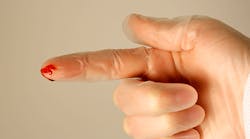The Winter 2017 edition of the Journal of the Association of Occupational Health Professionals in Healthcare (AOHP) includes the results of its member survey, which ascertained their most effective strategies to reduce sharps injuries and mucocutaneous blood exposures (BE) among their hospital staff.
AOHP’s EXPO-S.T.O.P. (EXPOsure Survey of Trends in Occupational Practice) was established as a nationally representative blood exposure database and benchmark resource and has completed its fifth consecutive annual survey. A 22-item electronic survey, for 2015 calendar year data was developed and distributed to AOHP members nationally and 181 hospitals responded with data suitable for inclusion. The results were published in “Proven Strategies to Prevent Bloodborne Pathogen Exposures in EXPO-S.T.O.P. Hospitals.”
In addition to surveying AOHP members for their BE incidence rates, the authors, Dr. Linda Good and Terry Grimmond, determined the top five facilities with the lowest BE incidence rates and interviewed them to ascertain the strategies that brought about such marked reductions.
“With an incidence of 320,000 annually, BE among healthcare workers continues to be a serious occupational risk that healthcare facilities strive to reduce,” explains Good, who is the manager of Occupational Health Services for Scripps Health in San Diego. “EXPO-S.T.O.P. has identified health care organizations with exposure rates nearly 50 percent below the national average. Analyzing their successful prevention strategies serves as a foundation for creative and effective best practices to reduce the persistent national problem of blood and body fluid exposures.”
The EXPO-S.T.O.P. study also identified that with a commitment to consistent prevention practices, even high risk areas such as the operating room can be made safer. Applying the hierarchy of exposure controls (eliminate use of sharps; use engineering controls; administrative controls; workplace controls; use personal protective equipment), will lessen the risk of blood exposure.
“Our analysis documents that, by using these proven successful strategies, sharps injuries are preventable,” says co-author Terry Grimmond, Director, Grimmond and Associates, New Zealand. “These best-practice strategies can be grouped into four categories: education and training (in use of safety engineered devices); communication; incident investigation; and staff engagement. The over-arching theme in each of the EXPO-S.T.O.P. Exposure Aware facilities is a culture of safety that is practiced at all levels of the organization, with zero incidence being the goal."
